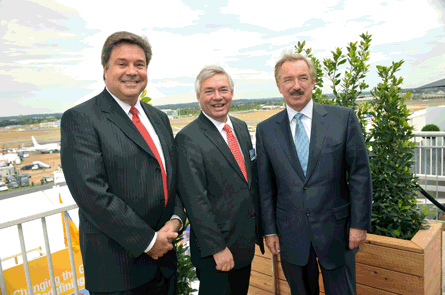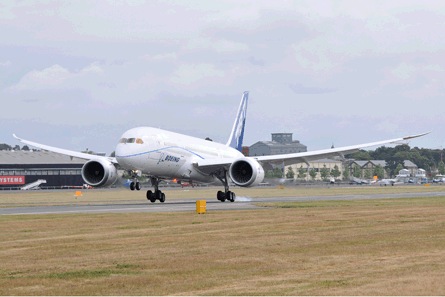As a barometer for the health of the airline industry, this year's Farnborough Air Show provided a further welcome shot in the arm. Hot on the heels of fast-improving passenger traffic, Airbus and Boeing racked up more than $50 billion in sales during Farnborough. ATR and Embraer also enjoyed a productive week, while there were orders for the Superjet 100, Antonov An-158 and MS-21 programmes.
The aircraft lessors were busiest, disclosing over 300 orders when RBS Aviation Capital's commitment for 95 Airbus/Boeing narrowbodies is included. This was in part driven by the return of the biggest name in the aircraft leasing business, Steven Udvar-Hazy. His new venture, Air Lease, placed orders for 125 aircraft across four different manufacturers as it aims to build a 200-strong portfolio within three years. GE Commercial Aviation Services (GECAS) meanwhile disclosed follow-on orders for another 60 A320s and 40 Boeing 737-800s during the show.
These orders serve as a reminder to the long-term strength of the industry. Deliveries in some cases will begin almost immediately, but for the most part these orders are about the medium to long-term picture. RBS Aviation Capital chief executive Barrett explains it wants to be ready as customers are reporting improving trends: "The recovery has started and we are seeing encouraging yields and load factors from airlines." Similarly, pointing to IATA's upwardly revised profits forecast, Air Lease chief executive officer - Hazy's fellow ex-ILFC executive John Plueger - says the lessor is capturing the market place at just the right time.
 |
|---|
Udvar-Hazy (right) with Airbus sales chief John Leahy (centre) during the Farnborough Air Show (© H.Gousse/Airbus) |
But he cautions this activity is not based on organic demand. "Basically, the financiers are betting that today's excellent air traffic recovery numbers continue, even though many airlines remain somewhat cautious about ordering." Pointing to doubts about the strength and durability of the world economic recovery, he says there are good reasons to be concerned about traffic growth stalling out. "If it does.these orders will slip further out. And once again the industry will be faced with overcapacity and slumping jet values and lease rates," he says.
FARNBOROUGH 2010 |
|---|
| For all the news, blogs, images and videos from this year's air show go to our Farnborough home page here |
But Tim Clark, chief executive at Emirates which also ordered 32 more A380 in June, says these and its existing A350/777 commitments effectively brings the current fleet expansion and replacement plan to a close. "Physical constraints are the single largest inhibitors to Emirates' growth - these include what airports can take the A380, how quickly the Dubai hub can be built to match our expansion, and airspace management issues," he says. "If it hadn't been for those inhibitors we would have made much larger orders for expansion over the next 10 years."
Other carriers in the market at Farnborough included Azul signing up for 40 ATR 72-600s and five more Embraer 195s. Carrier chairman David Neeleman says Azul, which will take the ATRs late next year, has a list of 40 cities in Brazil whose population is more than a half-million, and half those cities currently have no air service.
UK regional Flybe ordered Embraer 175 regional jets with a commitment that could reach 140 in total. Deliveries begin next year, but Flybe chief executive Jim French says it retains flexibility to temper its growth if required by either renewing leases or returning some of its Bombardier Q400s as necessary. French sees the 175s as the mainstay of its plans to expand into continental Europe, which also chimes with the carrier's recently-struck codeshare with Air France, as it see opportunities in the coming years resulting from consolidation in Europe. "There is always a second phase to consolidation. There's always a time to sit back and say 'Do I need all of this?'. Whatever happens, we are in a great position to take advantage of any opportunities," he says.
 |
|---|
Boeing's 787 touching down at Farnborough (©APG Photography) |
"We're in discussions with all three engine manufacturers but have not decided which one we're going to go with," says Boeing Commercial Airplanes chief executive Jim Albaugh on possible 737 re-engining. "We'll make a decision on the engine in the near term and then whether or not we do the re-engining programme this fall."
He adds Boeing will not bow to pressure from Airbus if its European rival decides to go ahead with its own single-aisle re-engining programme. Airbus is also targeting a year-end decision on whether to go with its proposed A320 New Engine Option. "The business case is very convincing," says chief executive Tom Enders, but "the main point Airbus must now verify [before deciding on a launch] is resource availability" given the strain the company is under the with A380 ramp-up and A400M flight-test and A350 development.
Bombardier Commercial Aircraft president Gary Scott meanwhile cites Airbus and Boeing's proposals to re-engine their narrowbodies with advance engines such as the CSeries' Pratt & Whitney PW1000G as a validation of its own product offering.
- All the latest news, video and images from the 2012 Farnborough air show
Source: Airline Business



















